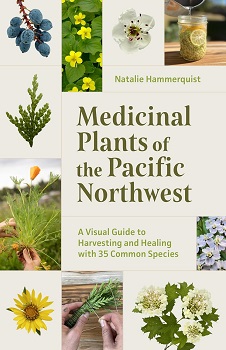Medicinal Plants of the Pacific Northwest: A Visual Guide to Harvesting and Healing with 35 Common Species by Natalie Hammerquist
Hikers beware! It’s the season for stinging nettles, and they’re all over the place on local trails. But one person’s hazard is another person’s healthy elixir — so if you’re like my friend, the minute you see new nettle leaves unfurling each spring, it’s cause for celebration. All it takes is some sturdy gloves, clippers and a gathering pouch.
This time of year, you can harvest the seeds, which are a fine addition to an herbed salt mix, and can be used to improve kidney health or even hair growth. But before you start foraging, be sure to read through Mountaineers Books’ 2024 offering, “Medicinal Plants of the Pacific Northwest: A Visual Guide to Harvesting and Healing with 35 Common Species.”
Author Natalie Hammerquist is an herbalist who studied plant taxonomy and food science at Evergreen State College and then studied under Cascade Anderson Geller, a highly regarded educator who led the botanical medicine programs at Bastyr University and Southwest College of Naturopathic Medicine.
Hammerquist grew up exploring the Cascades with family. She enjoys both foraging and preparing herbal medicines; her approach blends traditional Western herbalism with Chinese and British folk herbalism. Her book is practical and easy to navigate.
The first section discusses methods of harvesting medicinal plants. She includes basics like how to decipher Latin botanical names, a list of harvesting tools, a seasonal harvest calendar, and instructions on drying, processing and storing plant material.
Next, Hammerquist gives concise, clear instructions on how to prepare herbal medicine, including tinctures (alcohol extracts of medicinal plants), herbal teas, elixirs, cordials and syrups, infused oils and salves. Plentiful photographs are colorful and compelling.
In Part Two, Hammerquist runs through 35 medicinal plant species that are commonly found in the Pacific Northwest, from clack cottonwood to clackberry (blackberries are not only delicious eating, but members of the rose family, and used for diabetes, GI conditions, dental hygiene) to St. John’s Wort and Yarrow. Each species includes instructions on harvesting and lists medicinal uses.
Part Three is an illustrated list of the most common toxic and poisonous plants in our bioregion, many of which produce beautiful and tempting flowers but can be fatal to humans. Some have names to warn people (death camas, poison hemlock, chokecherry) but others are less obvious (larkspur, lupine).
If the poisonous plants haven’t scared you off, return to Part Two and ponder various recipes, like Nettle Sauerkraut, Mugwort Incense, Fir Tip Elixir or Hawthorn Chutney. Gathering the natural ingredients could enhance your next outdoor adventure with a botanical “I Spy” activity.
You can place a hold on this title at wcls.org. There are several others available on this topic: “Pacific Northwest Medicinal Plants” by Scott Kloos, and “Edible and Medicinal Flora of the West Coast” by Collin Varner are two worthy reads.
Don’t have a Discover Pass but would like to visit a Washington State Park for your foraging adventure? Borrow a Check Out Washington backpack from WCLS. You can find it in the library catalog by searching for Check Out Washington Discover Pass. Each backpack comes complete with binoculars and plant and wildlife identification guides in addition to a Discover Pass.
Christine Perkins is executive director of the Whatcom County Library System, wcls.org.
(Originally published in Cascadia Daily News, Friday, June 28, 2024.)

